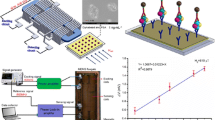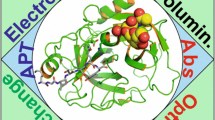Abstract
This paper reports the results of the development and testing of a bridge-shaped resonator to detect different concentrations of prostate specific antigen (PSA) based on shifts in resonant frequency. The bridge-shaped PZT resonator was fabricated by Micro Electro Mechanical Systems techniques, including photolithography, wet and dry etching, and film deposition. The prototype consists of multiple layers comprised of Ta/Pt/PZT/Pt followed by a supporting layer of SiNx. The resonant frequency of the bridge-shaped PZT resonator was measured in the air by a heterodyne laser doppler vibrometer, and the frequencies were 406 ± 3, 177 ± 2, and 121 ± 1 kHz for the dimensions of 50 μm × 250 μm, 100 μm × 500 μm, and 150 μm × 750 μm (width × length), respectively. Bridge-shaped PZT resonators of different geometries have been used to detect PSA over a wide range of concentrations from 10 pg/ml to 100 ng/ml, which includes the clinically relevant diagnostic range. Using the specific binding between PSA and PSA antibody, different concentrations of PSA can be detected through the change of resonant frequency caused by the mass of the bound PSA. The measured resonant frequency and the calculated mass of bound PSA were used to calculate mass sensitivity (S = Δf/Δm). Mass sensitivities of bridges with dimensions of 50 μm × 250 μm, 100 μm × 500, and 150 μm × 750 μm were 44.14, 18.90 and 8.31 Hz/pg, respectively. This shows that mass sensitivity increases as the dimensions of the bridge get smaller. The feasibility of detecting 10 pg/ml of PSA was confirmed, which is a much smaller amount than 4 ng/ml, which is the conventional cut-off point between a patient and a non-patient in clinical diagnostics.





Similar content being viewed by others
References
Benecke W (1989) Micromechanical sensors. In: CompEuro ‘89., ‘VLSI and Computer Peripherals. VLSI and Microelectronic Applications in Intelligent Peripherals and their Interconnection Networks’, Proceedings. pp 3/39–3/47
Chamritski I, Clarkson M, Franklin J, Li SW (2007) Real-time detection of antigen-antibody reactions by imaging ellipsometry. Aust J Chem 60:667–671
Chengkuo L, Itoh T, Suga T (1996) Micromachined piezoelectric force sensors based on PZT thin films Ultrasonics. IEEE Trans Ferroelectr Freq Control 43:553–559
Flynn AM, Tavrow LS, Bart SF, Brooks RA, Ehrlich DJ, Udayakumar KR, Cross LE (1992) Piezoelectric micromotors for microrobots. J Microelectromech Syst 1:44–51
Forsen E et al (2005) Ultrasensitive mass sensor fully integrated with complementary metal-oxide-semiconductor circuitry. Appl Phys Lett 87:043507. doi:10.1063/1.1999838
Hwang KS, Lee JH, Park J, Yoon DS, Park JH, Kim TS (2004) In-situ quantitative analysis of a prostate-specific antigen (PSA) using a nanomechanical PZT cantilever. Lab Chip 4:547–552
Ilic B, Czaplewski D, Zalalutdinov M, Craighead HG, Neuzil P, Campagnolo C, Batt C (2001) Single cell detection with micromechanical oscillators Journal of Vacuum Science and Technology B: microelectronics and nanometer structures 19:2825–2828
Ilic B, Yang Y, Aubin K, Reichenbach R, Krylov S, Craighead HG (2005) Enumeration of DNA Molecules Bound to a nanomechanical oscillator. Nano Lett 5:925–929. doi:10.1021/nl050456k
Lee JH, Hwang KS, Park J, Yoon KH, Yoon DS, Kim TS (2005) Immunoassay of prostate-specific antigen (PSA) using resonant frequency shift of piezoelectric nanomechanical microcantilever. Biosens Bioelectron 20:2157–2162. doi:10.1016/j.bios.2004.09.024
Lerman M, Elata D (2010) On the quality-factor of micro-resonators. Procedia Eng 5:95–98. doi:10.1016/j.proeng.2010.09.056
Lilja H, Ulmert D, Vickers AJ (2008) Prostate-specific antigen and prostate cancer: prediction, detection and monitoring. Nat Rev Cancer 8:268–278
Ozkumur E et al (2008) Label-free and dynamic detection of biomolecular interactions for high-throughput microarray applications. Proc Natl Acad Sci USA 105:7988–7992. doi:10.1073/pnas.0711421105
Polla DL (1997) Application of PZT thin films in microelectromechanical systems Proc. SPIE 3046, Smart Structures and Materials 1997: Smart Electronics and MEMS, 24; doi:10.1117/12.276603
Ray S, Mehta G, Srivastava S (2010) Label-free detection techniques for protein microarrays: prospects, merits and challenges. Proteomics 10:731–748. doi:10.1002/pmic.200900458
Rogers B et al (2003) Mercury vapor detection with a self-sensing, resonating piezoelectric cantilever. Rev Sci Instrum 74:4899. doi:10.1063/1.1614876
Shin S, Lee N, Park H, Park J, Lee J (2005) Piezoelectrically driven microtransducer mass sensors integrated ferroelectrics 76:93–100. doi:10.1080/10584580500413723
Tzou H, Lee HJ, Arnold S (2004) Smart Materials. Precision sensors/actuators, smart structures, and structronic systems mechanics of advanced materials and structures 11:367–393. doi:10.1080/15376490490451552
Wassaf D et al (2006) High-throughput affinity ranking of antibodies using surface plasmon resonance microarrays. Anal Biochem 351:241–253. doi:10.1016/j.ab.2006.01.043
Wu G, Datar RH, Hansen KM, Thundat T, Cote RJ, Majumdar A (2001) Bioassay of prostate-specific antigen (PSA) using microcantilevers Nat. Biotech 19:856–860
Xu T, Wang Z, Miao J, Yu L, Li CM (2008) Micro-machined piezoelectric membrane-based immunosensor array. Biosens Bioelectron 24:638–643. doi:10.1016/j.bios.2008.06.024
Yu X, Xu D, Cheng Q (2006) Label-free detection methods for protein microarrays proteomics 6:5493–5503. doi:10.1002/pmic.200600216
Zang M, Zurn SM, Robbins WP, Polla DL, Markus D (2001) Bridge structure PZT thin film microtransducer with mass loading”, Proc. SPIE 4435, Wave Optics and VLSI Photonic Devices for Information Processing, 152; doi:10.1117/12.451142
Acknowledgments
This research was partially supported by National Research Foundation grant funded by the Korea government (MEST) (Grant No: 2009-0091918, 2010-0020714). And also, this work was partially supported by the KIST Institutional Program (2E25474).
Author information
Authors and Affiliations
Corresponding author
Rights and permissions
About this article
Cite this article
Hwang, D.G., Chae, Y.M., Choi, N. et al. Label-free detection of prostate specific antigen (PSA) using a bridge-shaped PZT resonator. Microsyst Technol 23, 1207–1214 (2017). https://doi.org/10.1007/s00542-015-2804-0
Received:
Accepted:
Published:
Issue Date:
DOI: https://doi.org/10.1007/s00542-015-2804-0




